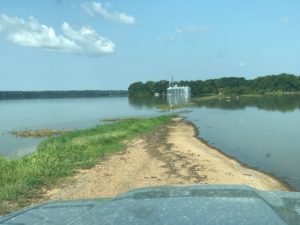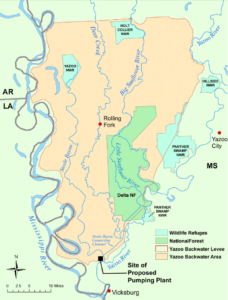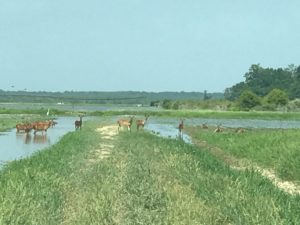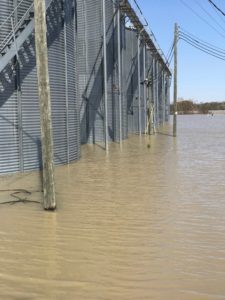The present

There are 550,000 acres that are flooded in the South Mississippi Delta. The need for the Yazoo Backwater Project originated almost a century ago.
Summer is normally the prime growing season for crops in this area. On a normal year, farmers start harvesting some crops as early as August. However, this year, the land has been underwater for almost six months.
My husband farms in this area and has for over 20 years.

The water is finally falling at a rate of one half-foot per day according to Peter Nimrod, the chief engineer for the MS Levee Board. It’s a slow process. But, farmers missed the opportunity to plant crops this year.
I love my country and respect anyone in public office, whether elected (Congress) or appointed (EPA). It would be a very hard job. My fear is, since the water is falling, that Congress and the EPA will sweep this under the rug and cross their fingers that it won’t happen again.
Hopefully, this will not be the case.
The distant past

I am from the Mississippi Delta, a little further north of the flooded area, but now live in Jackson, Mississippi.
My paternal grandfather was a farmer in Leland, Mississippi. My maternal grandfather worked for Staplecotn, AG Paxton Cotton, and a cotton company called Dan River. Additionally, my maternal great-grandfather was a farm manager.
Growing up in Greenville, seeing fields of cotton, corn, and soybeans was as normal to me as looking in the mirror.
However, I can remember bringing friends home from college for the MS Delta Blues Festival in September each year, and their being amazed at the beauty of the Mississippi Delta and all of the fields that we passed as we rode to Greenville because they had never seen fields of cotton, corn, and soybeans in person.
What was just beauty to them was many people’s livelihood in this area, and people and animals used the crops all over the world.
And it is no different today. Agriculture still drives the economy in the MS Delta.
The present and past collide
Back to the issue in the South Delta, I understand that the current members of Congress, are for the most part, not the ones responsible for the pumps originally not being put in. But, we must depend on the current members of Congress to make right what was done before their time.
I also understand that the current members of the EPA, which are appointed officials, are not the same members who vetoed the final step in the Yazoo Backwater Project in 2007. I know that the current EPA is reviewing a 10-year study provided by the Vicksburg District of the Corps of Engineers.

This study will show that their fear of damaged wetlands if the pumps are put in, isn’t warranted like they thought it would be back in 2007.
Basically, Congress and the EPA work together on environmental topics. According to the EPA’s website, “when Congress writes an environmental law, we implement it by writing regulations.”
I read through Section 404 of the Clean Water Act Yazoo Backwater Area Pumps Project. It would take me a year to read every word, but I scanned it and all of the links provided. It was very informative!
EPA’s involvement

The Environmental Protection Agency, or the EPA as it is known, was created in 1970 by President Nixon. This was in response to a concern about increased air and water pollution, according to their website.
In 2007, the EPA thought the wetlands in this area were sustained by backwater flooding.
This is not the case.
According to Nimrod, natural rainfall sustains the wetlands in most areas. Research can now better show the EPA after 10 years of study, that this is the case.
Hopefully, since members of the EPA have toured the area, met in Washington D.C., Atlanta, and Vicksburg about this issue, after reviewing the 10-year study, will amend their regulations.
I couldn’t even begin to name everyone from Mississippi who is helping get these pumps passed in Washington D.C., but I am appreciative of their efforts.
Rewind to the Great Flood of 1927

According to an article on the MS Levee Board website, 41% of the United States drains down the Mississippi River to the Gulf of Mexico. After the flood of 1927 when the levee broke just north of Greenville, Mississippi, in 1928, Congress passed the Flood Control Act which then created the Mississippi River & Tributaries Project (MR&T) “which called for levees and floodwalls, floodways, channel improvement and stabilization, and tributary basin improvements.”
Also, according to the MS Levee Board article, by 1936, Congress saw that some of these solutions “cut off drainage outlets for interior basins”, and the Flood Control Act of 1936 was passed “which extends federal responsibility to many river basins that feed into the MS River, including the Yazoo Basin.”
Fast forward to 1941; there is one problem

We are all human, and in creating one solution, as we have all done, they created another problem. That is common and understandable.
Also from the MS Levee Board article, per a request from Arkansas delegates, in 1941, the problem was, Congress removed the Eudora Floodway from the MR&T Project. Mississippi delegates tried to fight this because they knew that this would cause higher stages on the Mississippi River at the Yazoo River and “cause flooding in areas previously safe from flooding.” So, Congress passed the Flood Control Act of 1941, and created the Yazoo Backwater Project to protect the Delta area of Mississippi. This project included a combination of levees, drainage structures (gates), and pumps.
- Levees were completed in 1978.
- Drainage structures or gates were constructed. According to the Vicksburg District of the U.S. Army Corps of Engineers, Steele Bayou’s in 1969 and Little Sunflower’s in 1977.
- A connecting channel was completed in 1978. This sent water from the Big and Little Sunflower Rivers, Deer Creek, and Steele Bayou to bring “water from 4093 sq. miles of the Delta to one point at the Steel Bayou Drainage Structure where one pumping plant can be constructed.”
- The pumping plant was never constructed. Dirt work was completed in 1986 and a culvert put in around the site. But it has been continually vetoed ever since.
Three out of four areas “in the same boat” were given their promised pumps. Our area was not.
Hindsight 20/20; government would have netted 152 million by now
I listened very carefully to Peter Nimrod, chief engineer for the Mississippi Levee Board, when he spoke to a group of concerned citizens at the five-month mark of the flooding. According to Nimrod, the final step of the Yazoo Backwater Project–the pumping station would have paid for itself AND saved the federal government (the taxpayers) millions since 2008. Here’s how:
- The cost in 2007 (when it was vetoed) was going to be 220 million. That was for a pumping station smaller than what the other three areas received.
- From 2008-2018, the pumps would have paid for themselves in what has been paid out in flood relief, plus the government would have netted 150 million. And by “government” what I’m really meaning is “your tax dollars.”
- This doesn’t count how much they will pay out in damage from this year’s flood.
- Today’s proposed cost is 360 million for the pumping station. It is a 4-year project.
The future

I’m sure the EPA is also worried that one solution could create another problem. I get it. Currently, the EPA is reviewing the 10-year study. (Thank you, Corps of Engineers, for your 10-year study that will show that by solving our problem, the pumps shouldn’t create another problem…in the wetlands)
This is a new day with new people involved. What the flooding has done to the wildlife, people, and crops in this area is heart-breaking. I hope that the EPA will also see it that way and finally put in the final step of the Yazoo Backwater Project.
I’m hopeful for the future.


To read another article about my direct experience with the Forgotten Backwater Flood, you can click 5 Eye-Opening Issues From the Forgotten Backwater Flood. On Facebook, there is a group called Forgotten Backwater Flood. It has tons of information on this topic, images of the wildlife, and actions you can take to help get the pumps passed.

Read Laurie’s story of how a recent health scare led to the birth of this site, White Cotton.